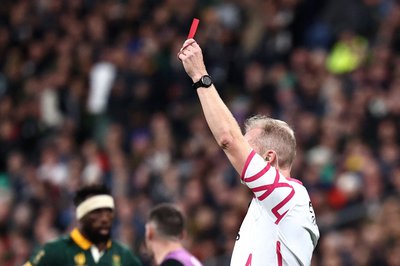“`html
## Concerns Rise Over Proposed Red Card Reform in Rugby
On Monday, both the French Rugby Federation (FFR) and the governing organization overseeing France’s premier leagues, the National Rugby League (LNR), expressed their apprehension regarding a proposal that could alter red card protocols. Earlier this year, World Rugby conducted a trial during the Rugby Championship that allowed teams to substitute a player who received a red card after 20 minutes spent in the sin-bin. This initiative has garnered support from national unions in South Africa, Australia, and New Zealand.
### The Devaluation of Consequences?
Wales lock Dafydd Jenkins conveyed his worries to reporters about this potential change. ”I see this as potentially undermining the seriousness of receiving a red card,” he remarked. While acknowledging both sides of the discourse—pros and cons—he criticized ongoing attempts to overhaul rugby unnecessarily. “The game is already well enough as it stands,” he added at an event introducing this season’s Champions Cup.
### Opposition from Players’ Union
In alignment with FFR and LNR stances, Provale—the union representing French players—also opposed adopting such a policy due to insufficient evidence backing its efficacy. The union cautioned that easing penalties might encourage riskier behavior on the field; they noted that among 480 matches sampled from Top 14 and international fixtures, only 60% of teams facing red cards ultimately lost.
### Player Safety Versus Game Dynamics
The debate between enhancing player safety while preserving game integrity is ongoing. Ireland’s No 8 Caelan Doris articulated this tension: “We need to balance player safety with not compromising game excitement when early reds occur.” He also indicated support for trialing new ideas within controlled environments.
What do proponents of the red card rule in rugby argue for?
“`html
Rugby’s Red Card Dilemma: Divisive Opinions Ignite Global Debate!
Understanding the Red Card Rule in Rugby
The red card in rugby union serves as a significant disciplinary action, indicating that a player must leave the field for serious breaches of the rules. This can encompass behaviors such as:
- Violent conduct
- Foul play
- Using excessive force
Players who receive a red card leave their team disadvantaged, often leading to heated discussions among fans, players, and officials alike. As rugby evolves, debates surrounding the interpretation and enforcement of the red card rule have grown increasingly fierce.
The Consequences of a Red Card
Receiving a red card has immediate and long-term consequences for players and teams. Key implications include:
- A mandatory 10 minutes suspension, followed by potential bans depending on the severity of the incident.
- Impact on team strategy, as teams must adjust to playing with one less player.
- Psychological effects on teammates, often leading to a defensive, reactive playing style.
Global Perspectives: The Divisive Opinions
The red card rule has invited polarized opinions across the rugby community. Advocates argue that it promotes player safety, while critics claim it disrupts the flow of the game. Here’s a look at both sides:
Proponents’ Views
Supporters of strict red card enforcement emphasize:
- Player Safety: Enhanced safety measures help protect players from serious injuries.
- Fair Play: Enforcing strict punishments instills a culture of respect on the field.
- Deterrence: A clear red card policy may deter players from engaging in dangerous behavior.
Critics’ Arguments
On the other side, critics highlight several concerns:
- Game Flow Disruption: Reduced player counts affect the natural progression and excitement of the match.
- Subjectivity: The interpretation of what constitutes foul play can vary, leading to inconsistencies.
- Over-punishment: Critics argue that some offenses may deserve a yellow card rather than an outright red.
Case Studies: Incidents That Sparked Debate
Several high-profile rugby matches have ignited heated discussions over the use of red cards, serving as case studies in conflict and resolution.
Case Study 1: The 2015 Rugby World Cup
During the 2015 Rugby World Cup, a notorious red card was issued to a player for a high tackle. Opinions on this call varied, with some praising the referee’s commitment to safety while others lamented the loss of a key player in a critical match. This incident highlighted the ongoing debate over how much discretion referees should have.
Case Study 2: The Controversial Tackle in 2020
A controversial tackle led to a player’s red card during a significant international matchup in 2020. Social media erupted with divided opinions, showcasing a clearer generational divide: younger fans supported the strict enforcement of safety protocols, while older fans valued the traditional ruggedness of rugby.
Benefits of Clear Guidelines on Red Cards
Clear guidelines on red card policies can offer numerous benefits, including:
- Consistency: Establishing defined criteria for red card issuance ensures fair treatment across the board.
- Player Education: Educating players on the consequences of infractions can foster accountability.
- Fan Engagement: Transparent decision-making can enhance viewers’ connection to the sport, as understanding context is crucial.
### Legal Challenges Highlighting Increasing Care for Players’ Health
Concerns regarding head injuries have been amplified following announcements by former players initiating lawsuits against World Rugby over inadequate protective measures during their careers. Ireland winger Jacob Stockdale emphasized mental health safeguarding: ”Prioritize head injury prevention should be at our forefront.” However, he cautioned that more stringent regulations may lead to an uptick in red card incidents throughout games.

La Rochelle’s UJ Seuteni has experienced both yellow and red cards throughout his career arc—a notable incident occurred in the pivotal semi-final against Toulouse in 2021 when he was ejected for head contact with Romain Ntamack while tackling back when competing with Bordeaux-Begles.
“I believe revisiting these concepts benefits our sport,” Seuteni shared regarding contemporary tackle rules concerning head collisions, noting that efforts are always made toward maintaining fair play but occasionally result in unexpected outcomes leading to disciplinary actions.
### The Challenge of Maintaining Fair Play Amidst Tactical Shifts
Recent alterations by World Rugby have focused on limiting legal tackle heights amid an increasingly frantic gameplay pace across matches—a reality echoed by Racing 92 full-back Tristan Tedder: “Everything unfolds so rapidly these days.” Consequently altering body mechanics while attempting tackles creates additional complexities; even lowered body heights can still inadvertently lead to dangerous impacts upon shoulders or heads if tacklers aren’t careful.
World Rugby plans rigorous analysis on findings from recent trials before submitting it for approval at their executive board meeting set for November 14th; should it receive endorsement, changes could be implemented beginning January 1st.
“`



